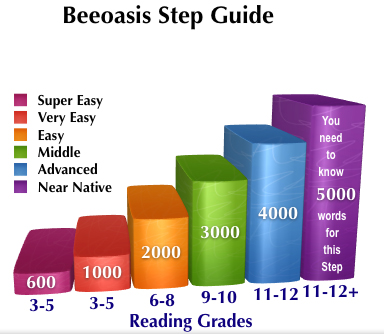BeeOasis: Big Things in Basic English
English is a second language, and sometimes third, for nearly all of my international and Japanese students. And though I do not teach English as a second language, per se, some of what I do in and out of the classroom amounts to that. This is especially true when it comes to evaluating reading comprehension and writing.
Often it is difficult, without a significant level of personal interaction, to determine whether a student is struggling primarily because of weak English abilities or primarily because of incomprehension of the subject (to some degree, of course, it is usually both/and). In fact, the same can be said about native English speakers who read and write below their “grade level” (what percentage is that in the U.S., I wonder).

A person can attain a high level of comprehension when they understand 95% of the vocabulary in a given piece of writing (assuming that the syntax is not contorted, etc.). As understanding drops, comprehension breaks down. The typical person becomes increasingly frustrated, loses self-confidence, and develops self-defeating feelings and attitudes towards reading and, consequently, towards discussing and writing about their reading.
I am collaborating with Joseph Poulshock, one of my colleagues at Tokyo Christian University, and Sang Valte, a wiz at website design, to do something about these and other problems. We are building a website (beeoasis.com) with hundreds, and eventually thousands, of short “stories” (more like brief articles and essays) about topics spanning the liberal arts, sciences, and current events.
We are not re-creating the wheel. This is not a spin-off of Wikipedia, Newser, and the like. How is it different?
Each “story” is composed or adapted to meet the criteria of one or more “graded” levels, or steps. For instance, the vocabulary terms used in the stories are determined as follows:
- Step SE: 95% of the words are from the top 660 English words.
- Step 1: 95% of the words are from the top 1000 English words.
- Step 2: 95% of the words are from the top 2000 English words.
- Step 3: 95% of the words are from the top 3000 English words.
- Step 4: 95% of the words are from the top 4000 English words.
- Step 5: 95% of the words are from the top 5000 English words.

This approach has something to offer to people of various ages and English levels.
Adult ESL learners and young native speakers reading at step 1, for example, can enjoy reading about “big ideas” in language they can understand. This will build confidence, make reading more pleasurable, and contribute to their liberal, and liberating, education.
 RSS - Posts
RSS - Posts
Welcome to the blog world. Looking forward to your insight.